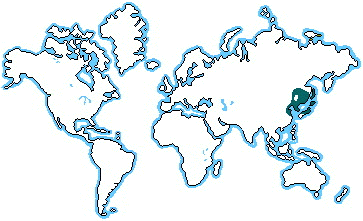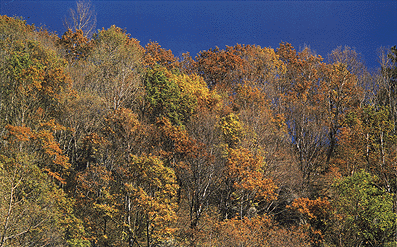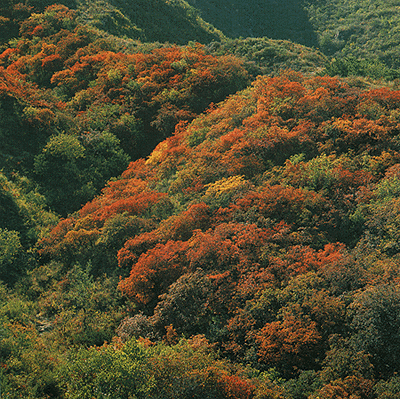Historical State of Ecosystem
 |
| [http://www.blueplanetbiomes.org/ne_asian_decid_forest.htm] |
The Northeast Asian temperate deciduous forests covers the northern part of China, the Korean peninsula, as well as Japan. This ecosystem poses a wet summer - dry winter cycles with seasonal temperature changes. With monsoons and typhoons hitting the northeast coast during the summer, precipitations vary throughout the year from as low as 12 inches per year to above 30 inches per year.
 |
| [http://www.sbs.utexas.edu/levin/bio213/biomes/wulinshan.html] |
Due to the seasonal changes and nature of a temperate climate, temperatures vary throughout the year from as low as -10 degrees F to mid 70 degrees F. The large changes in climate throughout the year have lead to plant adaptations where tree leaves change colors in the fall, falls off completely in the winter, and regrow back during the spring; this allows for the trees to survive the cold winters.
Many animals live within these ecosystems including red-crown cranes, pandas, leopards, Siberian tigers, and goat-like animals call gorals. Plants such as the Mongolian oak, Daurian birch, Manchurian elm, Asian ginseng, and the iconic Bamboo trees thrive within the ecosystem
 |
| [http://www.sbs.utexas.edu/levin/bio213/biomes/wulinshan.html] |
Not only is the ecosystem home to various plants and animals, due to the seasonal changes and rich soil, temperate deciduous ecosystems are popular for human settlement. The northeastern Asian temperature deciduous forests is home of most of the major cities in China, South and North Korea, and Japan. These include major cities such as Beijing, Shanghai, Soul, and Tokyo.
 |
| [http://www.worldpopulationstatistics.com/beijing-population-2013/] |
Historical Status and Conservation Efforts
Due the high population in the northeast region of China, the historical status of the Northeastern Asian Temperate Deciduous forest is bad. Recent industrialization and farming have caused deforestation on some areas and have also lead to pollution of the water and air. Not only is industrialization affecting the ecosystem, according to a study published in the Annals of Forests Science, tourism has contributed in many areas to the forest fragmentation and deforestation. Because of the heavy deforestation, endangered animals that are exclusive to the are have been killed off: such as the red-crown crane and giant pandas. Without the trees, floods have been an increasing issue which further compound the issue of habitat loss for local species.
Pollution also affects the region. Especially air pollution that leads the acid rain. The figure below shows sulfur dioxide levels which is the main constituents of acid rain. As seen, although the northeast region is not the highest density of sulfur dioxide in the air, some still exist in the area. The acid rain affects soil acidity levels and contributes to plan species in the area dying off. This lost of plant species is also a loss of habitat for the animals in the ecosystem and thus causes animal population to die off also.
However, in response, many conservation efforts have been employed in the past few years. Just early this year, forestry authorities in China have banned commercial logging in the northern forests. Although many times, centralized governmental preservation efforts often get over overrun by industrial and economic developments, recent forests conservation efforts have put China's northeastern forests back towards a healthy trend. As shown below, apart from areas in North Korea, the northeastern Asian forest regions have actually had a increased in forest area. In fact, from 1990 - 2005, East Asia has the highest change in forest land compared to any regions around the world.
 |
| [http://www.greenpeace.org/eastasia/campaigns/forests/problems/] |
 |
| [http://english.mep.gov.cn/SOE/soechina1997/images/1.gif] |
However, in response, many conservation efforts have been employed in the past few years. Just early this year, forestry authorities in China have banned commercial logging in the northern forests. Although many times, centralized governmental preservation efforts often get over overrun by industrial and economic developments, recent forests conservation efforts have put China's northeastern forests back towards a healthy trend. As shown below, apart from areas in North Korea, the northeastern Asian forest regions have actually had a increased in forest area. In fact, from 1990 - 2005, East Asia has the highest change in forest land compared to any regions around the world.
 |
| [http://www.nytimes.com/2005/11/15/science/earth/15forest.html?_r=0] |
Many of China's original forests also remain and are preserved for environmental and religious reason. Other conservation efforts include the Shaungtai Hekou Natuare Reserve which provide safe breeding grounds and shelter for the endangered red-crown birds. Conservation agencies from outside the area has also begun to provide help. The National Trust began conservation efforts in 2000 for South Korea's forests In South Korea. Many Non Governmental Organizations (NGO's) such as the Northeast Asian Forest Forum and Forests for Peace have also played a role in conservation efforts of forests.
 |
| [http://www.environmentmagazine.org/sebin/d/w/T2_Ostrom.jpg] |
What Can Be Done?
Although forest conservation is incredibly important, the Northeast Regions especially in China serves as a large economic hub of the world. Considerations must be taken with regards to economy but a good balance between environmental conservation a economic gains must be found. Through continual conservation efforts of the agencies and organizations shown above, the North Eastern Asian Forests can be restored. New nature reserves should be made to bring endangered species population up while environmental programs should be enacted in the high-populous cities in the regions to control pollution. A environmental cooperation between the countries of the region would also help in the conservation efforts of the forests.
Zhao, J., Li, Y., Wang, D., Xu, D, "Tourism-induced deforestation outside Changbai Mountain Biosphere Reserve, northeast China", Annals of Forest Science, Vol. 68, Issue 5. pp 935-941.
http://link.springer.com/article/10.1007/s13595-011-0099-6#page-2
http://www.tandfonline.com/doi/abs/10.1080/13504509.2012.675599#tabModule
http://news.mongabay.com/2014/0422-morgan-gfw-hinggan.html#sthash.xXZALgn7.dpbs
Fund, W., & Hogan, C. (2014). Northeast China Plain deciduous forests. Retrieved from http://www.eoearth.org/view/article/154891
Fund, W., & Hogan, C. (2014). Northeast China Plain deciduous forests. Retrieved from http://www.eoearth.org/view/article/154891
hdurwiadergw ewrgte
ReplyDeletehbzhbdshyegrgbecgy trwygtr uyughugr
okay!
Deletetrue
ReplyDeletehi ms. downing :)
ReplyDelete